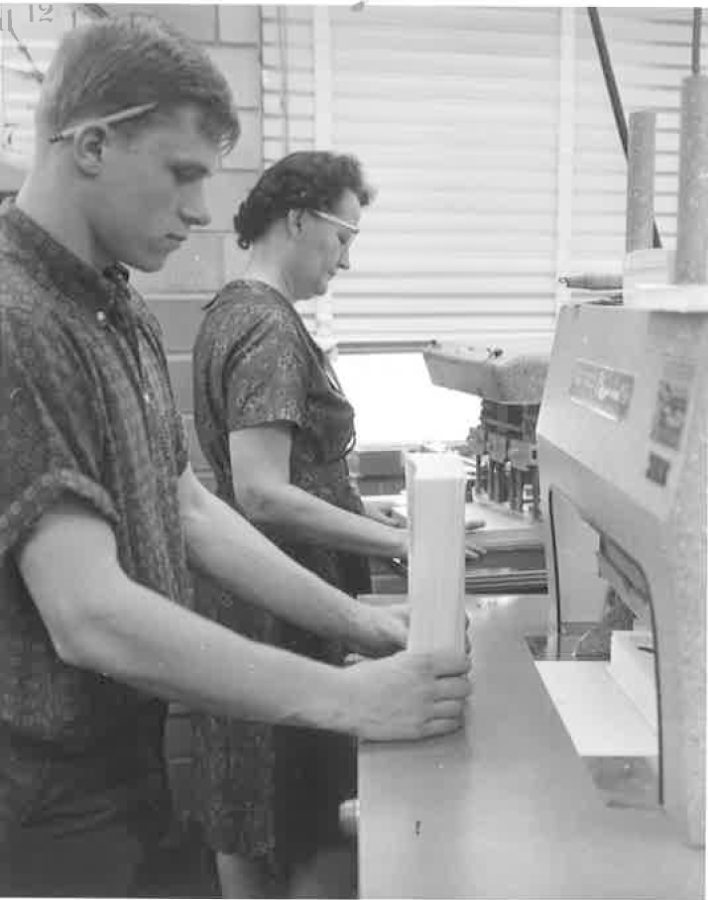Faculty observe changes in university technology, campus culture during past 50 years
In 1965, Gary Hoenick worked for printing services on the second floor of what is now Snedecor Hall. After 51 years of service, Hoenick plans to retire in September 2014.
October 2, 2013
Fifty years ago, if students wanted to go to watch a basketball game, instead of crossing Lincoln Way to Hilton Coliseum, they would head the opposite direction, to the Armory.
This is just one of many ways Iowa State has transformed during the past 50 years.
Francis Laabs, an ISU employee since 1966, said he especially noticed the technological advances and campus expansion during his nearly 50 years at Iowa State.
Hired as a storekeeper with ISU Printing and Copy Services in 1963, Gary Honeick has witnessed skyrocketing student enrollment, faculty additions and building relocation during his half-century stay at the university.
When Honeick arrived at Iowa State, basketball played in the Armory; the football team played near where State Gym is now; CyRide didn’t exist; nearly everybody went to the Memorial Union for a cafeteria style meal; and the Veterinary Medicine building was not so far away from Central Campus.
“Initially when I started on campus here, Vet Med was over in the Lago[marcino] complex,” Honeick said. “I remember going over there and watching them operate on horses. You had this big area around the surgery area [that’s] glassed in. It was pretty cool.”
When Honeick was first hired, the printing services was in Snedecor Hall, where the university computer was also housed. In 1968, it was moved to its current location north of campus near Ames Laboratory buildings.
In addition to building relocations, Honeick said one of the greatest changes in the university he has noticed is the technology usage.
“When I first started in 1963, [Snedecor Hall] was wall to wall computers. Computers took up rooms, floor to ceiling. And now [everything] is as big as your hand,” Honeick said. “It’s amazing how computers and desktops have changed.”
Laabs initially joined Ames Laboratory to do research with electrochemistry toward the end of the Manhattan Project and has dealt with technological shifts firsthand.
“When I started, there were two levels of computers: personal levels and [the ones] that we used in the lab,” Laabs said.
Laabs worked with the centralized computing in Snedecor Hall where the process for a batch was a multi-step and multi-day process.
“For complex jobs, it would probably take about a week,” Laabs said. “Now, you could probably do the same thing in a few hours.”
Ames Lab started as a U.S. Department of Energy lab doing materials research and development for the end of the Manhattan Project. Back when Laabs joined, the lab was under high security.
“We were looking at uranium, nuclear fuel [and] containment vessels,” Laabs said. “We had armed guards at the door, photo nametags to check in and security clearance.”
Laabs said the shift for the lab performing more diverse research projects was due to Congress waiting until the last minute to get a fiscal year budget completed.
Having 10 percent of its budget cut, the lab was forced to cut 30 percent of the staff and find additional funding from multiple sources, instead of solely the Department of Energy. Since then, the lab has become multipurpose in different areas, Laabs said.
“It’s sort of exciting because we get to work on all sorts of stuff,” Laabs said.
Another change Honeick and Laabs said they have noticed is the culture of how people dine. When both started, the Memorial Union was the main place to eat with a cafeteria-style buffet.
Laabs said surroundings used to be quieter.
“I like the old system better,” Laabs said. “It was a quiet place where I could go over and read. That’s probably why they changed it. It was probably too quiet.”
Both Laabs and Honeick said a significant change they’ve noticed, in addition to technology, is student enrollment.
“In 1963, there were [11,517] students,” Honeick said. “There was a big boom in the mid-‘70s with the Vietnam War. To avoid the draft, many guys stared enrolling in school.”
Laabs said he has noticed an increase in international students as well.
“When I first started, you’d see one or two non-Iowan people,” Laabs said.
The increased number of students also brought different fashion fads through the years.
“People pay now to get pants with holes in them. … I used to throw them away,” Laabs said. “I didn’t realize I was sitting on a gold mine.”
Although student enrollment has continuously increased, a CyRide system has been implemented and buildings have constantly been built, both Laabs and Honeick emphasized two elements of Iowa State have remained the same: Central Campus and the positivity of students.
“Central Campus has been very stable,” Laabs said. “It’s unique. It’s special. We don’t want to see it cluttered up. None of us do, students, faculty, staff. In today’s world, a space like that is precious.”
Laabs said the reason he has stayed around Iowa State so long is because of the people he works with and the positivity in the student body.
“[Students] are one of the reasons I continue to refuse to quit. I love working here because I like the people,” Laabs said. “Students are so positive.”
Honeick said he has enjoyed his time at Iowa State, but plans to retire in September 2014, totaling 51 years employed at the university.
“It’s a great place to work,” Honeick said. “It’s been fun. With all the students around, it kind of keeps me thinking young.”







